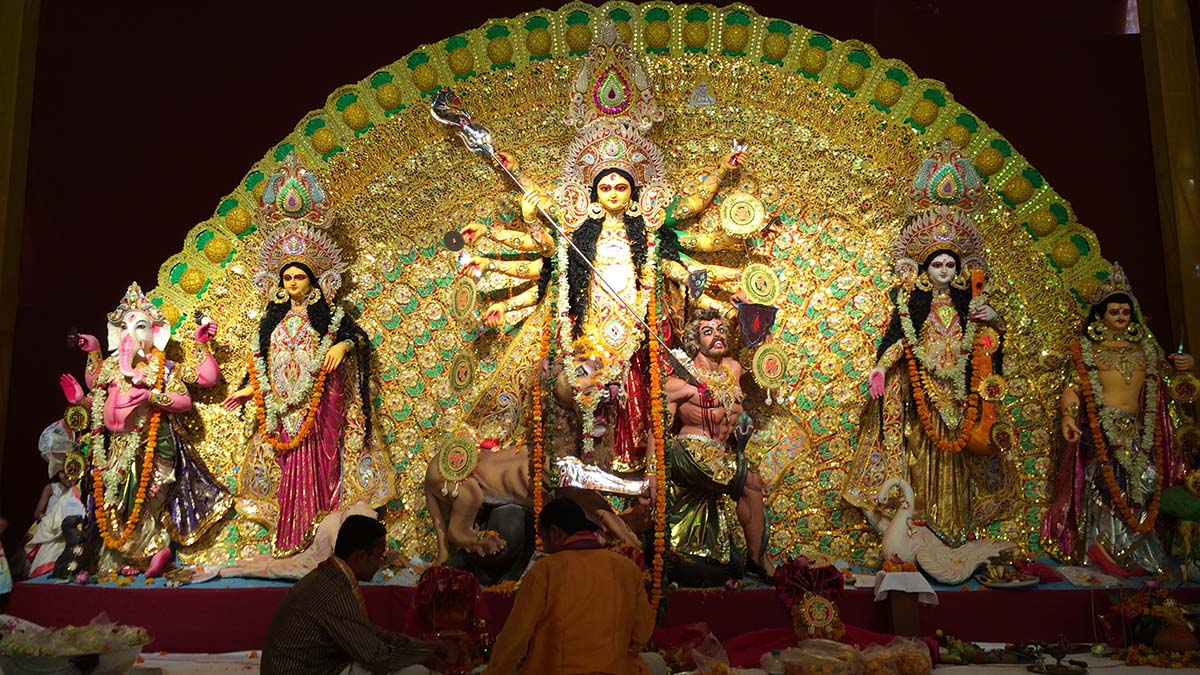
The Celebration of Victory of Good Over Evil
by Susmita Sengupta
Durga Puja, the celebration of the victory of the warrior Mother Goddess Durga over the buffalo demon Mahishasur, is a major annual Hindu festival in India. Although primarily a festival for Bengalis in the state of West Bengal, it is observed not just all over India but also around the world wherever Bengalis have made their homes. The festival dates are determined according to the lunar calendar and the days for the festivities are in the autumn in September or October. The festival period, also known as Navratri in the northern parts of India is ten days long. However, from the sixth day to the tenth it also becomes Durga Puja for Bengalis. The Puja season starts from Mahalaya which is seven days before the sixth day of Navratri or the first day of Durga Puja. Legend has it that on Mahalaya, the Goddess lets go of her fearsome fighter aspect and leaves her heavenly abode at Mount Kailash in the Himalayas to visit her earth mother with her children. On this day, devotees pray to their ancestors and it officially marks the arrival of Durga Puja. The Mother Goddess is invited to descend to earth through the chanting of mantras and by singing devotional songs.
For me, throughout my growing up years in India, Durga Puja meant dressing up in new clothes and visiting the puja venue not just for Anjali (the offering of flowers to the goddess with the accompaniment of Sanskrit mantras) but also to catch up with friends to compare notes on our clothes and accessories and finishing up with the biggest attraction, the delectable and mouthwatering selections of food.
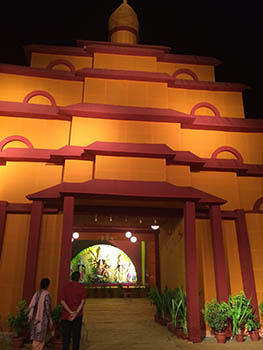 Curiously, from the 1930s an early morning radio program has become synonymous with Mahalaya. This audio program known as “Mahishasur Mardini” or “The Destruction of Mahishasur” is a compilation of chants, devotional songs and recitations from “Chandi Mangala Kavya”, a holy scripture that can be translated as “The Auspicious Poetry of Chandi”, where Chandi is a namesake of Durga. These poems are a hallmark of medieval Bengali Hindu literature that eulogizes the worship of a particular god or goddess. Mahishasur Mardini was recorded by All India Radio and is narrated by Birendra Krishna Bhadra who, because of this recording is an iconic name in all Hindu Bengali households.
Curiously, from the 1930s an early morning radio program has become synonymous with Mahalaya. This audio program known as “Mahishasur Mardini” or “The Destruction of Mahishasur” is a compilation of chants, devotional songs and recitations from “Chandi Mangala Kavya”, a holy scripture that can be translated as “The Auspicious Poetry of Chandi”, where Chandi is a namesake of Durga. These poems are a hallmark of medieval Bengali Hindu literature that eulogizes the worship of a particular god or goddess. Mahishasur Mardini was recorded by All India Radio and is narrated by Birendra Krishna Bhadra who, because of this recording is an iconic name in all Hindu Bengali households.
A favorite childhood memory of mine is of waking up at 4 am, the original broadcast time, to the sounds of this nearly two hour audio show, our home reverberating with the echoes of the sacred conch shell, and the recitation of the divine Sanskrit chants with a background of acoustic drama. In today’s modern world, it is not unusual to see Bengali families around the world turning to various other sources such as TV, CDs, and also the internet to hear this seven decades old Mahalaya audio montage to signal the beginning of the Puja season. That is what we do too. Early on Mahalaya morning we go to youtube and listen to the recording and an air of festivity fills up our home far, far away from India.
The story of Durga that is told in this audio program is as follows. There was increasing cruelty by the demon king Mahishasur in the world of gods. Unable to bear the tyranny any longer, the gods beseeched Lord Vishnu to help them. So the holy trinity of Vishnu (The Preserver), Brahma (The Creator) and Shiva (The Destroyer) got together and created Goddess Durga or Mahamaya, an all-powerful female form with ten arms. She was the Mother Goddess who emerged from the collective energy of all gods and was the primeval source of all power. She was then bestowed with the weapons of all the gods and blessed to do the needful. Armed thus like a warrior, Durga rode a lion into a fierce battle with Mahishasur, the buffalo demon king and slayed him with her trident. There was great joy in heaven and earth at her victory.
Thus the show ends with Sanskrit intonations invoking the blessings of Goddess Durga for all mankind. She is invited to come down to earth from the heavens which she does while accompanied by her four children, the goddesses Lakshmi (deity of wealth), and Saraswati (deity of knowledge, music, arts and wisdom), and the gods Kartikeya (god of war) and Ganesh (elephant headed god of auspiciousness and remover of obstacles).
Following the day of Mahalaya, the preparations for Durga Puja begin in earnest. Statues of Durga and her children are put up in neighborhoods of cities, towns and villages. The artisans or idol makers had started their work in the month of July. Traditionally, a dollop of mud from a prostitute’s home is used to start the creation of the clay mix for the Durga idol. It is then mixed with clay from various sacred river beds and patted on to the basic grass model that gradually takes the idol shape. The idols are painted and dressed in the finest of silks and bedecked with flowers and jewelry and transported to all corners of India and even abroad for the Puja. In anticipation of the arrival of the idols, parks, community centers, or any available block of land is rented by Puja organizers weeks before the beginning of the festival. Money for all expenses is raised through donations and sponsorships by local residents and businesses. The venues are transformed into an arena for celebration by the putting up of pandals which is a kind of a temporary shelter or tent. While some of these pandals might just be a simple construct consisting of a large colored cloth on upright poles covering a swath of space, most nowadays are complex, artistic and architectural structures built exclusively with bamboo, clay, cloth and coir.
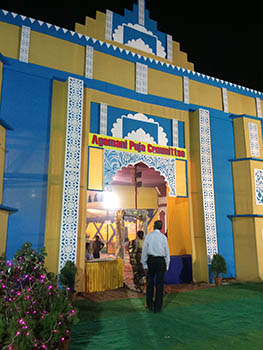 The best of the innovative pandals with highly creative and inspiring decorations can be seen in Kolkata, in the eastern part of India, capital of the state of West Bengal and the true hub of Durga Puja. In recent years, pandals in Kolkata have taken shapes of the London skyline, Buddhist temples, illuminations of dinosaurs and other prehistoric animals, replicas of historic Indian temples and even highlighting issues of social cause such as empowerment of women. Pandals are lighted up with thousands of twinkling lights and chandeliers and devotees after entering would make their way in to see the Durga idol. Pandal hopping is now a time honored ritual of Puja and it is not unusual to see long lines of people waiting to get a glimpse of a magnificent pandal. The number of Pujas in Kolkata, whether communal or in households have numbered upwards of four thousand. An air of fun and frolic, devotion and gaiety fills up the city.
The best of the innovative pandals with highly creative and inspiring decorations can be seen in Kolkata, in the eastern part of India, capital of the state of West Bengal and the true hub of Durga Puja. In recent years, pandals in Kolkata have taken shapes of the London skyline, Buddhist temples, illuminations of dinosaurs and other prehistoric animals, replicas of historic Indian temples and even highlighting issues of social cause such as empowerment of women. Pandals are lighted up with thousands of twinkling lights and chandeliers and devotees after entering would make their way in to see the Durga idol. Pandal hopping is now a time honored ritual of Puja and it is not unusual to see long lines of people waiting to get a glimpse of a magnificent pandal. The number of Pujas in Kolkata, whether communal or in households have numbered upwards of four thousand. An air of fun and frolic, devotion and gaiety fills up the city.
Durga Pujas in Mumbai, the financial capital of India, are highlighted by the glitz and glamor of Bollywood stars, some of whom being Bengalis, are the organizers of their community pujas. People crowd the pandals to get a glimpse of their favorite stars and getting bhog (holy food) served by them.
In the capital city of New Delhi, Durga Puja is primarily a neighborhood community festival, with all of them being organized by Bengali expatriates. There are close to 400 pujas in Delhi and while the city does not vibrate with the same energy as Kolkata, there is a definitive informal charm in the celebrations. That being said, in recent years some of the old, established puja pandals have started following the trend of themed pandals and pandal hopping too is coming to the fore.
After a gap of almost twenty years, I visited a Durga Puja Pandal in New Delhi, India with my family and was immediately transported back to the days of my childhood. The crisp, cool autumn evening air was redolent with the sweet aroma of burning incense and the rhythmic beating of the dhaak drums.
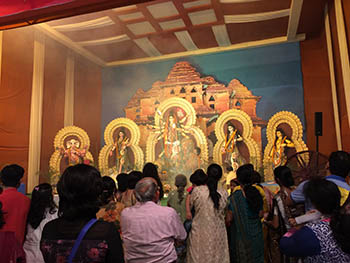 No matter where Durga Puja is celebrated, whether in India or abroad, the rituals and traditions followed are the same, handed down over hundreds of years.
No matter where Durga Puja is celebrated, whether in India or abroad, the rituals and traditions followed are the same, handed down over hundreds of years.
On Mahalaya, the first ritual of Durga Puja, known as Chokkhu Dan takes place. This means the bestowal of eyes to Goddess Durga. While all the idols are all dressed up and ready in the pandal, Durga’s face remains hidden, waiting for the auspicious moment of Chokkhu Dan, when the eyes are drawn on her face. The next six days are spent in final preparations for the five day event. Bengalis prepare by decorating their homes and buying gifts and new clothes for themselves, and their friends and family. Schools and colleges remain closed in West Bengal for Puja holidays though not anywhere else in India. Inside the pandal, the Puja area is filled up with all items needed by the priest for the prayers which would include clothes, fruits, flowers, vegetables and sweets. On one end of the pandal a stage would be built where entertainment programs of music, dance and drama take place in the evening on all five days. Some pandals will also have stalls selling clothes, books and jewelry where devotees can indulge in some festival time shopping. Providing meals for devotees is an equally important part of the celebration. These include lunch and dinner being provided sometimes for more than two hundred people at a time. All visitors, often times numbering in the thousands are also given bhog prasad which is the holy food offering made to the deity. It is also not unusual to see elaborate food stalls in the pandals, serving a variety of delicacies.
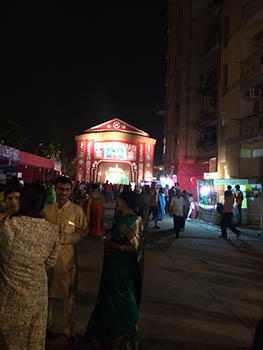 The five days of the Puja are observed as Shashthi, Saptami, Ashtami, Navami and Dashami, also known as Vijayadashami or Dusshera which is also the penultimate day of Navratri. On Shashthi, the first day of Durga Puja, there is celebration of the arrival of the deity to the mortal abode of earth by the symbolic unveiling of her face. The next three days are devoted to the worship of the goddess, with devotees on all days offering Pushpanjali, meaning offering of flowers, accompanied by Sanskrit chants. Ashtami, the third day of the Puja is characterized by Sandhi Puja, when the goddess is worshipped in her warrior form to the accompaniment of 108 oil lamps and 108 lotus flowers along with clothes, jewelry, sweets, vegetables, fruits and flowers. Sandhi Puja which begins in the last 24 minutes of Ashtami ends with the arrival of Navami, the fourth day of the Puja.
The five days of the Puja are observed as Shashthi, Saptami, Ashtami, Navami and Dashami, also known as Vijayadashami or Dusshera which is also the penultimate day of Navratri. On Shashthi, the first day of Durga Puja, there is celebration of the arrival of the deity to the mortal abode of earth by the symbolic unveiling of her face. The next three days are devoted to the worship of the goddess, with devotees on all days offering Pushpanjali, meaning offering of flowers, accompanied by Sanskrit chants. Ashtami, the third day of the Puja is characterized by Sandhi Puja, when the goddess is worshipped in her warrior form to the accompaniment of 108 oil lamps and 108 lotus flowers along with clothes, jewelry, sweets, vegetables, fruits and flowers. Sandhi Puja which begins in the last 24 minutes of Ashtami ends with the arrival of Navami, the fourth day of the Puja.
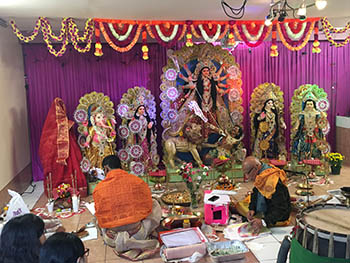 On the last day of Dashami, all the idols are carried in a procession with much fanfare and are immersed in a nearby lake or river. This event, known as Visarjan, meaning immersion in water, marks the end of Durga Puja.
On the last day of Dashami, all the idols are carried in a procession with much fanfare and are immersed in a nearby lake or river. This event, known as Visarjan, meaning immersion in water, marks the end of Durga Puja.
Although I had attended many pujas over the years in New York City, nothing beats the glory of experiencing Durga Puja in India. What is interesting is that a religious festival over the years has transcended to become a truly social and cultural event that is open to all.
If You Go:
Durga Puja is celebrated in virtually all cities and towns of India that has a Bengali population. If you are in India during the Puja dates, ask any local resident of the place you are in about the location of the local Puja as some of the towns will generally hold a much more intimate, neighborly Durga Puja. Almost all pujas are free to enter.
If visiting crowded areas is not your cup of tea, you can also check out the channel ABP Ananda if there is access to a television. The program Puja Parikrama, (where parikrama, a Sanskrit word meaning circumambulation around an object of devotion) shows viewers pandals from all over India and abroad and is a nifty way to experience Durga Puja without the hustle and bustle.
It is also possible to visit pujas on your own and it is better to visit the pandals during daytime to avoid the crowds. However, it is a magical experience seeing the brightly lit and decorated pandals at night.
Future Durga Puja dates:
2017: September 26 – 30
2018: October 14 – 18
2020: October 22 – 26
2021: October 11 – 15
2022: October 1 – 5
About the author:
Susmita Sengupta is a freelance writer who loves to travel. She and her family have visited various parts of the USA, Canada, Europe, the Caribbean, Middle East, Southeast Asia and India. She is a regular contributor at www.travelthruhistory.com
All photos by Susmita Sengupta
A close up view of Goddess Durga and her four children
Durga idol inside a pandal, the heavily decorated makeshift tent
A beautifully designed pandal
Devotees in front of the Goddess
A Durga Puja celebration in a housing society
A Durga Puja in New York






Leave a Reply
You must be logged in to post a comment.